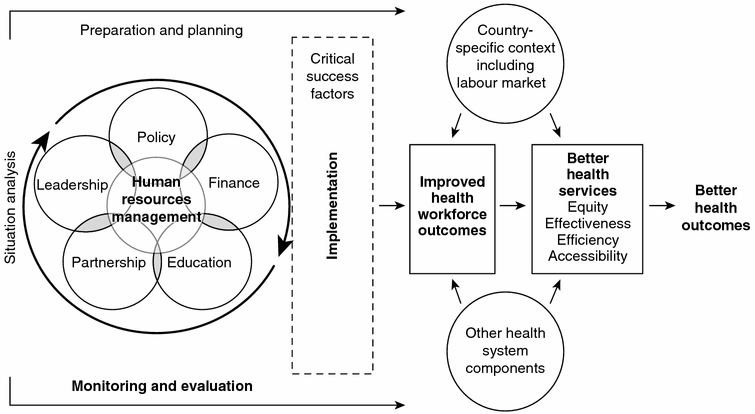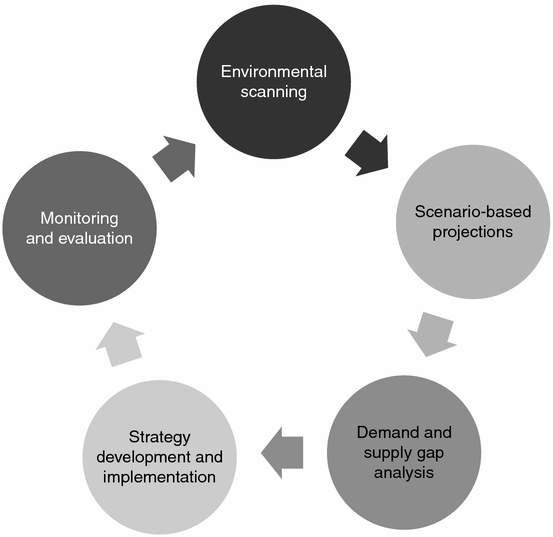- Workforce-planning
An ongoing business process aimed at ensuring the right people with the right skills are in the right place at the right time and at the right cost
Workforce-planning is not a rigid linear process. Many considerations are needed to inform the plan, and yet the future is never static, so the plan must remain dynamic if it is to serve the purpose for which it has been designed. To this end the World Health Organization (2010, p. 3) notes, ‘It is therefore critical that [workforce] plans include mechanisms for adjustment according to changing ongoing circumstances. Making projections is a policy-making necessity, but is also one that must be accompanied by regular re-evaluation and adjustment’.
Furthermore, health services are forever being asked to curtail costs, forcing workforce plans to find innovation and reform that can reduce ever-growing workforce costs. In 2005 the Australian Productivity Commission (2005, p. 9) noted that ‘productivity enhanced improvements in health workforce arrangements are critical to ensuring a sustainable health care system, particularly given the constraints on government funding for health care’. The expectations on healthcare executives to provide efficient and effective workforce plans now and into the future are clear.
Australia’s healthcare workforce
In the 2006 Australian census, it was estimated that 550 000 people worked in healthcare occupations and a further 300 000 worked in community care services such as aged care, social welfare and child protective services. Since 2001, healthcare occupations such as those listed in Table 28.1 had grown by an average of 22 per cent, while the national growth in jobs was around 6 per cent, making healthcare the fastest growing occupational group in the country. Furthermore, healthcare expenditure had grown from $89 billion in 2001–02 (8.4 per cent of gross domestic product) to $140 billion in 2011–12 (9.5 per cent of gross domestic product), with the highest cost burden being that of labour, at about 70 per cent of the total budget (Australian Institute of Health and Welfare, 2014b).
| Occupation | Status/type breakdown | No. of status/type | % of all healthcare workers | Total no. in occupation | Changes as % of 2008 figures |
|---|---|---|---|---|---|
| Medical practitioners | Practising | 81 910 | 89.5 | 91 504 | + 16.4 |
| Non-practising | 9 594 | 10.5 | |||
| Nurses and midwives | Practising | 290 144 | 86.8 | 334 078 | + 6.8 |
| Non-practising | 43 934 | 13.2 | |||
| Allied health professionals | Psychologists | 29 414 | 23.2 | 126 788 | n/a |
| Pharmacists | 27 005 | 21.3 | |||
| Physiotherapists | 23 962 | 18.9 | |||
| Occupational therapists | 14 327 | 11.3 | |||
| Medical radiation practitioners | 13 312 | 10.5 | |||
| Other | 18 768 | 14.8 | |||
| Registered dental practitioners | Dentists | 14 596 | 75.0 | 19 462 | + 26.0 |
| Therapists/hygienists | 4 865 | 25.0 |
The many anomalies identified in the Australian health workforce profile possibly represent the consequences of poor workforce-planning. For instance, the number of overseas-born doctors and nurses in Australia has increased in recent years. In 2011, more than half of general practitioners (56 per cent) and just under half of specialists (47 per cent) were born overseas, up from 46 per cent and 37 per cent respectively in 2001. In comparison, less than a third (28 per cent) of the total employed population in 2011 were born overseas. In 2011, it was identified that one-third (33 per cent) of nurses in Australia were born overseas, compared with one-quarter (25 per cent) in 2001 (Australian Bureau of Statistics, 2013). Australia is a signatory to a number of global and regional codes of practice relating to the recruitment of internationally trained health professionals. Under the codes, Australia must refrain from actively recruiting health professionals from those countries that are experiencing a lack of trained health professionals (World Health Assembly, 2010).
Conversely, the globalisation of the nursing profession has facilitated more Australian nurses to move overseas to work (Australian Institute of Health and Welfare, 2013b). This may assist in balancing the impact of migration flows, although the current and historical data informing this analysis need to be reviewed for anomalies.
Some aspects of the allied health workforce also have idiosyncrasies that may contribute to adverse workforce outcomes for Australia. Mak, Clark, March and Gilbert (2013) performed a number of studies on the pharmacist workforce in Victoria and South Australia, finding a significant proportion of pharmacists were not in clinical roles. There was also a level of dissatisfaction related to various factors within the profession, which could affect future attrition, something that professional leaders and policy-makers need to address to avoid future adverse outcomes.
Significant efforts have been made to increase the number of graduating healthcare professionals in Australia in recent years. For instance, the number of student enrolments leading to provisional registration as a medical practitioner more than doubled from 7900 in 2001 to 16 900 in 2011, with more women enrolled than men. The proportion of medical student enrolments completed by international students increased from 15 per cent in 2001 to 18 per cent in 2011. There were 45 400 students enrolled in a general nursing course required for initial registration in 2011; this is twice the number of enrolments in 2001 (22 600). During this time, the proportion of nursing students who were international students also increased, from 3 per cent in 2001 to 15 per cent in 2011 (Australian Bureau of Statistics, 2013).
Notwithstanding some improvement in health workforce data and statistics, the Australian government identified the need for a unifying, whole-of-country approach to health workforce-planning and advice and so commissioned the formation of Health Workforce Australia in 2009 to improve national-level health workforce-planning and -training arrangements. The first reports on health workforce projections, covering all medical practitioners and nurses, were released in April 2012 (Health Workforce Australia, 2012a), followed by a report focusing on medical specialty projections in November 2012 (Health Workforce Australia, 2012b).
- Health workforce projection
A forecast or estimate of what the workforce delivering health services may look like in the future
In the baseline (comparison) scenario, Australia is expected to have a shortage of 2701 physicians and 109 490 nurses by 2025. These Health Workforce Australia (2012a) projection models were based on scenario methods (see below). Despite these gloomy predictions, between 2011 and 2014 Australia experienced a relative oversupply of nurses. In South Australia, newly graduating nurses (37 per cent) and graduating midwives (15 per cent) were not able to gain entry positions to the Transition to Professional Practice Program, while in Tasmania it was reported that many graduates of nursing found themselves moving interstate or leaving the profession altogether, as there were simply not enough jobs for them all (Australian Nursing Federation, 2013).
The irony of this bizarre situation is not lost on Australian health system policy-advisors, who on the one hand state that the country cannot afford to support the current numbers of healthcare graduates from the nation’s universities, and on the other must concede that all of them (and more) are needed if Australia is to achieve health workforce sustainability by 2025. The need for careful and considered workforce-planning has never been as important to the survival of Australia’s healthcare system as we currently know it (Mason, 2013).
- Health workforce sustainability
Maintenance of the specific staff (doctors, nurses, allied health professionals, specialist support staff) required to meet the health needs of the given area or population
Framework for workforce-planning
Organisations that do not follow a structured cyclical model of workforce-planning expose themselves to reactive workforce-planning activities such as international recruitment campaigns, which may become necessary as a response to acute increases in service demand or shortages in workforce supply. Many conceptual models have been developed to provide a framework through which workforce-planning can be understood and followed, and several are easy to find online (for example, see Advisory Group on Reform of Australian Government Administration, 2010; Chief Information Office, 2013; Department of Human Services, 2012).
The World Health Organization (2010) and several partners developed the HRH (Human Resources for Health) Action Framework (see Figure 28.1), which includes six action fields (human resources management systems, leadership, partnership, finance, education and policy) and an action cycle, which illustrates the phases to follow in applying the framework (situational analysis, planning, implementation, and monitoring and evaluation). To ensure a comprehensive approach to a given challenge, users of the framework are advised to address all action fields and phases of the action cycle, paying particular attention to the set of critical success factors. (For more detailed analysis and background information, see the HRH Action Framework website: http://www.capacityproject.org/framework.)

Figure 28.1 HRH Action Framework. World Health Organization. (2010). Models and tools for health workforce planning and projections (Human Resources for Health Observer, Issue no. 3, p. 4, fig. 1). Retrieved (29 January 2015) from http://whqlibdoc.who.int/publications/2010/9789241599016_eng.pdf?ua=1. Reproduced with the permission of the publisher.
By adapting the four HRH Action Framework action cycle phases to create five cycle phases with minor modifications to language and emphasis, we have developed a simple action-planning or change management cycle involving an ongoing, sequenced process to facilitate the stakeholder engagement critical to successful planning outcomes (see Figure 28.2). Before being discussed in detail, the five action cycle phases are listed below followed in brackets by the corresponding HRH Action Framework phases:
- environmental scanning (situational analysis)
- scenario-based projections (planning)
- demand and supply gap analysis (planning)
- strategy development and implementation (implementation)
- monitoring and evaluation (monitoring and evaluation).

Figure 28.2 Action-planning cycle involving an ongoing, sequenced process
Stay updated, free articles. Join our Telegram channel

Full access? Get Clinical Tree


